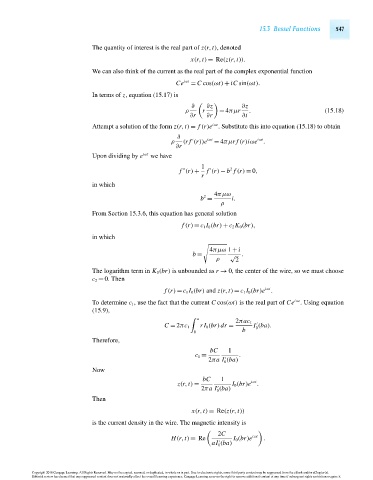Page 567 - Advanced_Engineering_Mathematics o'neil
P. 567
15.3 Bessel Functions 547
The quantity of interest is the real part of z(r,t), denoted
x(r,t) = Re(z(r,t)).
We can also think of the current as the real part of the complex exponential function
Ce iωt = C cos(ωt) + iC sin(ωt).
In terms of z, equation (15.17) is
∂
∂z ∂z
ρ r = 4πμr . (15.18)
∂r ∂r ∂t
iωt
Attempt a solution of the form z(r,t) = f (r)e . Substitute this into equation (15.18) to obtain
∂
iωt
ρ (rf (r))e iωt = 4πμrf (r)iωe .
∂r
Upon dividing by e iωt we have
1
2
f (r) + f (r) − b f (r) = 0,
r
in which
4πμω
2
b = i.
ρ
From Section 15.3.6, this equation has general solution
f (r) = c 1 I 0 (br) + c 2 K 0 (br),
in which
4πμω 1 + i
b = √ .
ρ 2
The logarithm term in K 0 (br) is unbounded as r → 0, the center of the wire, so we must choose
c 2 = 0. Then
iωt
f (r) = c 1 I 0 (br) and z(r,t) = c 1 I 0 (br)e .
To determine c 1 , use the fact that the current C cos(ωt) is the real part of Ce . Using equation
iωt
(15.9),
a
2πac 1
C = 2πc 1 rI 0 (br)dr = I (ba).
0
b
0
Therefore,
bC 1
c 1 = .
2πa I (ba)
0
Now
bC 1
iωt
z(r,t) = I 0 (br)e .
2πa I (ba)
0
Then
x(r,t) = Re(z(r,t))
is the current density in the wire. The magnetic intensity is
2C iωt
H(r,t) = Re I 0 (br)e .
aI (ba)
0
Copyright 2010 Cengage Learning. All Rights Reserved. May not be copied, scanned, or duplicated, in whole or in part. Due to electronic rights, some third party content may be suppressed from the eBook and/or eChapter(s).
Editorial review has deemed that any suppressed content does not materially affect the overall learning experience. Cengage Learning reserves the right to remove additional content at any time if subsequent rights restrictions require it.
October 14, 2010 15:20 THM/NEIL Page-547 27410_15_ch15_p505-562

